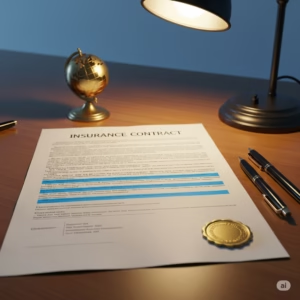5 common mistakes when taking out insurance and how to avoid them
Learn about some common mistakes when applying for insurance

Navigating the world of insurance can be tricky, and it’s easy to make missteps that could leave you underinsured, overpaying, or both. Whether you’re buying auto, home, health, or life insurance, understanding common pitfalls can save you significant money and stress down the line. This article highlights five frequent mistakes people make when getting insurance and offers simple, actionable advice on how to avoid them.
Mistake #1: Being Underinsured or Overinsured

One of the most common errors is having either too little or too much coverage.
- Underinsurance: This happens when your policy limits are too low to adequately cover potential damages or liabilities. For example, if your home is insured for $200,000 but would cost $300,000 to rebuild after a disaster, you’re underinsured. Similarly, minimal auto liability limits might not cover serious accident damages, leaving you personally responsible for the rest.
- Overinsurance: This occurs when you pay for more coverage than you realistically need. Insuring an old car for its replacement value instead of its actual cash value, or having a life insurance policy far exceeding your dependents’ financial needs, are examples.
How to Avoid It:
- Regularly Assess Your Needs: Review your policies annually or whenever a major life event occurs (marriage, new baby, home purchase, new car, career change).
- Understand Replacement vs. Actual Cash Value: For property, know if your policy pays out based on what it costs to replace an item new, or its depreciated value.
- Calculate Your Life Insurance Needs: Consider your debts, income replacement, future expenses (education, retirement), and existing savings. Don’t just pick a random number.
Mistake #2: Not Comparing Quotes from Multiple Providers

Many people stick with the same insurance company year after year without exploring other options, or they simply choose the first quote they receive. This is a huge missed opportunity for savings.
- The Problem: Insurance premiums can vary widely between companies for the same coverage, sometimes by hundreds or even thousands of dollars per year. Loyalty alone rarely guarantees the best rate.
- Lack of Competition: If you don’t shop around, insurers have no incentive to offer you their most competitive pricing.
How to Avoid It:
- Shop Around Annually: Make it a habit to get quotes from at least three different insurance companies every year, especially for auto and home insurance.
- Use Comparison Tools: Utilize online comparison websites or work with an independent insurance agent who can do the shopping for you across multiple carriers.
- Be Specific: Provide the exact same coverage details (deductibles, limits, riders) to each insurer to ensure you’re comparing “apples to apples.”
Mistake #3: Neglecting Available Discounts

Insurance companies offer a surprising number of discounts, but they won’t always automatically apply them. It’s up to you to know what’s available and ask for them.
- Common Overlooked Discounts: Multi-policy (bundling auto and home), good driver, good student, anti-theft devices, home security systems, defensive driving courses, low mileage, paid-in-full, paperless billing, professional association memberships, and even non-smoker discounts on life insurance.
- Missed Savings: Failing to inquire about these can leave money on the table that is rightfully yours.
How to Avoid It:
- Ask, Ask, Ask: Whenever you get a quote or review your policy, explicitly ask your agent or the company representative about all available discounts.
- Be Proactive: If you’ve recently installed a security system, completed a defensive driving course, or paid off your car, inform your insurer.
- Check Online: Many insurance company websites list their available discounts.
Mistake #4: Misrepresenting Information (Even Accidentally)

It might be tempting to fudge details to get a lower premium, but providing inaccurate information on your insurance application can have serious consequences. This also applies to not updating information when circumstances change.
- The Risk: If an insurer discovers you provided false or incomplete information (e.g., mileage driven, primary driver of a vehicle, home security features, health history on a life insurance application), they can deny a claim, cancel your policy, or even retroactively charge you higher premiums. This is known as “rescission” and can leave you without coverage when you need it most.
- Innocent Mistakes: Even honest mistakes can lead to issues, which is why reviewing your application carefully is crucial.
How to Avoid It:
- Be Honest and Accurate: Always provide truthful and complete information on your insurance application.
- Update Your Information: Inform your insurer promptly about any significant changes – new drivers in your household, major home renovations, a change in vehicle usage, or moving to a new address.
- Read Before You Sign: Carefully review your application and policy documents to ensure all details are correct.
Mistake #5: Focusing Only on the Price (Ignoring Coverage & Service)

While saving money is important, choosing the cheapest policy without understanding what it covers (or doesn’t cover) is a critical error. Similarly, neglecting the insurer’s reputation for customer service can be problematic.
- The Pitfall: A seemingly low premium might come with high deductibles, low coverage limits, numerous exclusions, or a difficult claims process. You might save a few dollars monthly but face massive out-of-pocket costs or headaches if you need to file a claim.
- Customer Service Matters: When you’ve had an accident or a disaster strikes, you want an insurance company that is responsive, helpful, and fair in handling your claim.
How to Avoid It:
- Read the Policy (or at least the Summary): Understand what is and isn’t covered, including deductibles, limits, and exclusions. Don’t just look at the premium.
- Check Insurer Ratings: Look up financial strength ratings (e.g., A.M. Best, Standard & Poor’s) and customer satisfaction scores (e.g., J.D. Power, Consumer Reports) for the companies you’re considering.
- Ask About the Claims Process: Understand how claims are filed and what to expect during the process.
- Balance Cost with Value: Aim for the best value, which combines competitive pricing with adequate coverage and reliable service.
Secure Your Future: Smart Insurance Choices
Avoiding these common mistakes can lead to better protection, significant savings, and greater peace of mind. Take the time to understand your needs, compare your options, and actively manage your insurance policies. Your financial well-being depends on it.





